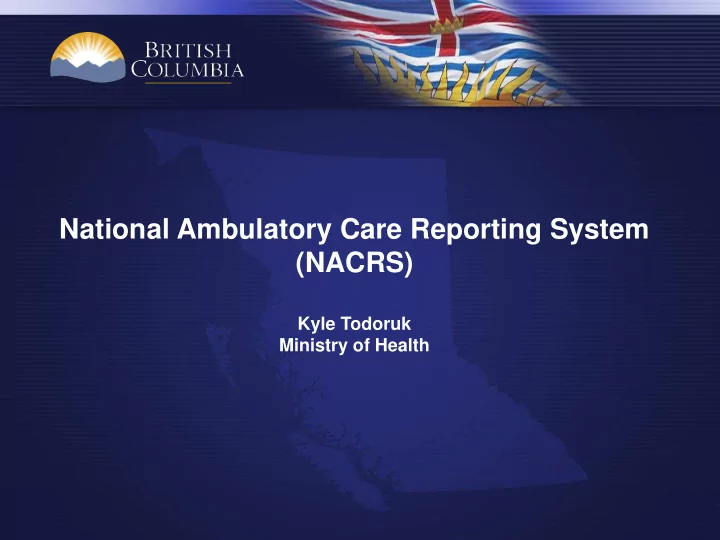

National Ambulatory Care Reporting System (NACRS) Kyle Todoruk Ministry of Health
Background: The National Ambulatory Care Reporting System (NACRS) is a tool for collecting data and reporting on all levels of ambulatory care within Canada including Emergency Departments ( ED’s ), day surgery, and medical and surgical day clinics within hospitals, the community and private clinics.
BC hospitals provide a significant proportion of urgent and emergent care in BC - each year there are approximately 2 million ED visits. Roughly 11% of these visits result in an admission to an inpatient bed, however the record doesn’t contain full information on their time in the ED, which is the first part of their hospital episode of care. The remaining 89% or 1.8 million visits per year are patients that are treated and released from the ED and for these patients data is very limited.
NACRS Expected Implementation Schedule by Site 15 Mandated Sites
NACRS provides 3 data submission options for Emergency Department data as follows: • NACRS Level 1 Data Submission • Includes data elements that are readily available from hospital ADT and/or EDIS systems. These data elements include those required for ED Wait Time indicators • NACRS Level 2 Data Submission • Builds on Level 1 data elements and adds 2 additional elements: Presenting Complaint or ED Discharge Diagnosis collected using pick lists. (Diagnosis are automatically coded to ICD-10-CA) • NOTE: Both Presenting Complaint and ED Discharge Diagnosis pick-lists will be submitted in BC.
• NACRS Level 3 Data Submission • Level 3 data submissions includes the full set of NACRS data elements including coder assigned ICD-10-CA/CCI diagnoses and intervention codes
NACRS LEVEL 2 DATA ELEMENTS There are four streams of data that will be available through NACRS Level 2: 1) Wait Time Indicators 2) Demographic 3) Clinical 4) Administrative
1) Wait Time Indicators • Physician Initial Assessment Date/Time • Triage Date/Time • Registration Date/Time • Disposition Date/Time • Patient Left ED Date/Time
2) Demographic • Admit via Ambulance • Responsibility for Payment • Gender • Birth Date/Estimated Birth Date • Province/Territory Issuing Health Care Number • Postal Code
3) Clinical • Triage Level • Presenting Complaint • Visit Disposition • Discharge Diagnosis
4) Administrative • Abstract Identification Number • Coder Number • Submission Level Code • Health Care Number • Chart Number • Visit MIS Functional Centre Code Account • ED Visit Indicator • Chart Number • Submission Fiscal Year and Period • Reporting Facility’s Ambulatory Care Number and Province/Territory
NACRS is currently in 20 Emergency Departments throughout the province, which account for about 43% of the total ED visits in BC in a given year.
Collection of NACRS level 2 data presents a rich opportunity to fill existing gaps. Increased patient level information on ED visits could be used to: -assess the impact of integrated Primary and Community Care models on reducing utilization of hospital services -Monitor quality and safety improvement initiatives across the health care system -Inform contract negotiations with ED physicians -Monitor and assess the effectiveness of ED pay-for-performance projects -Assess the impact of programs for target populations such as Injury Prevention , Mental Health, and Addictions Programs -Identify ED overcrowding and access issues.
THANK YOU
Recommend
More recommend